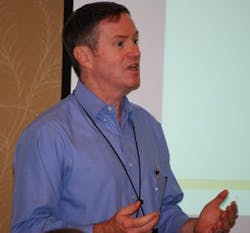Sustainable Chemistry Can Mean Good Business Too
Julia Child would be so proud.
Adding just a pinch of green chemistry and sustainable attributes to your drab, routine process action reports can transform them into delicious and healthy recipes for sustainability that comply with environmental rules and improve your bottom line, too. Bon appetit!
Well, like any cooking show, this sounds easy. Actually doing it is a little bit harder—but not too much.
To help specialty chemical engineers add some of these sustainable practices to their processes, Dennis Brandl, of BR&L Consulting, presented "Manufacturing Science Model Extensions to Address Product and Process Stability" at the 2009 Invensys North America Client Conference this week in Houston.
Brandl demonstrated that, while green chemistry can help users comply with sustainability regulations, it also can be very good for productivity, profitability and other business goals. Specifically, he reported on his work with Pfizer to help it redesign several pharmaceutical production processes to reduce the solvents it uses and their resulting waste, eliminate some unit operations, but increase productivity and remove solvents from another process, but still increase its yield. He also described how users can adopt green chemistry and sustainable practices in their own processes and achieve similar gains.
To get everyone on the same page, Brandl introduced several primary concepts in green chemistry and sustainability. For example, he reported that "manufacturing science" describes the body of scientific knowledge, regulations and principles involved in transforming materials and information into products, and that one of its components is the development of scientifically sound recipes based on sustainability principles. Next, he defined sustainability as a "characteristic of a process or state that can be maintained at a certain level indefinitely."
"In manufacturing, this means development and deployment of processes and products that conserve energy, reduce waste materials, reduce use of non-sustainable materials in the production processes, and increase the recyclability of products and waste materials," said Brandl. "As a result, we develop processes that don't produce more waste than they need to and don't use more energy than they need to."
Brandl added that green chemistry in the life sciences is closely related to sustainability because it also seeks to:
- Prevent waste,
- Design safer chemicals and products,
- Design less hazardous chemical syntheses,
- Use renewable feedstock,
- Use catalysts, not stoichiometric reagents,
- Avoid chemical derivatives,
- Maximize atom economy,
- Use safer solvents and reaction conditions,
- Increase energy efficiency,
- Design chemicals and products to degrade after use,
- Analyze in real time to prevent pollution,
- Minimize potential for accidents.
"Sustainability can deliver significant economic benefits." Dennis Brandl of BR&L Consulting demonstrated how green chemistry can help manufacturers comply with regulations as well as enable productivity, profitability and other business goals.
Similarly, he added that Pfizer improved its sildenafil manufacturing process by reducing solvent usage of 22 liters/kg to 7 liters/kg by improving the synthesis route and by implementing more efficient solvent recovery. As a result, Pfizer received the U.K. Green Technology award in 2003 for these efforts by improving its e-factor to a 6 rating.
Likewise, because Pfizer's atoravastin calcium (Lipitor) product uses a key hydroxy nitrile (HN) building block, Brandl explained that its Codexis partner devised three bioengineered enzymes to improve volumetric productivity by 100 fold of the reduction reaction and improve its cyanation reaction by 4,000 fold over the HN process. "This resulted in a new process with fewer unit operations, improved yield and worker safety, and reduced formation of byproducts, waste and equipment usage," said Brandl. "Codexis received the 2006 Presidential Green Chemistry award for Greener Reaction Conditions."
Finally, Pfizer developed a new enzymatic route for manufacturing its gabapentin (Lyrica) product. "It eliminated organic solvents from three reaction steps, while increasing the overall yield. This also minimized waste significantly," he said.
To develop and achieve some of these green chemistry and sustainability gains, Brandl stressed that users must examine both their product development and their process development, and then consider the sustainability factors associated with those products and processes, such as waste, non-renewable resources and energy. Generally, green chemistry is part of intermediate and final activity pharmaceutical ingredient (API) production steps, and the waste material issues tend to crop up during the unit dosage manufacturing and packaging steps.
"The task on the manufacturing side is how to best capture these steps. The ISA 88 batch standard defines general recipes and capturing chemical and other process steps," explained Brandl. "As a result, there are 30 to 40 basic tasks you can do in these manufacturing processes, and this gives us a library of items for which we can consider the sustainability factors and possibly add them to the process action step.
"For instance, we can look at a general recipe and then also ask about its waste and recovered material. So we're looking at what it takes to make a product and what it takes to reduce its waste at the same time," he said. "For example a typical process action report for a blending application might have numbers on weight, density, moisture and other physical characteristics, but a sustainability report on a process action will add measurements of energy use, waste and/or recovered material to the batch record." This consideration of sustainability factors also can be plugged into a general recipe model or added during other steps, such as the R&D product synthesis description, global equipment property descriptions, global material specifications and global process definition.
"In general, sustainability can deliver significant economic benefits," said Brandl. "But there also will be additional information needed, such as e-factors, material disposal costs and other waste issues. Still, general recipes will provide a good basis for manufacturing alternatives and documenting sustainability."


